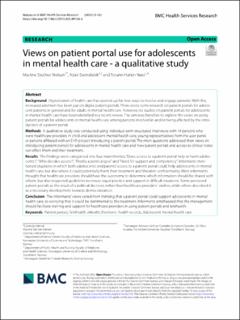| dc.contributor.author | Steinsbekk, Aslak Irgens | |
| dc.contributor.author | Nøst, Torunn Hatlen | |
| dc.date.accessioned | 2023-10-16T09:18:31Z | |
| dc.date.available | 2023-10-16T09:18:31Z | |
| dc.date.created | 2023-02-10T15:46:10Z | |
| dc.date.issued | 2023 | |
| dc.identifier.issn | 1472-6963 | |
| dc.identifier.uri | https://hdl.handle.net/11250/3096667 | |
| dc.description.abstract | Background
Digitalization of health care has opened up for new ways to involve and engage patients. With this, increased attention has been put on digital patient portals. There exists some research on patient portals for adolescent patients in general and for adults in mental health care. However, no studies on patient portals for adolescents in mental health care have been identified in a recent review. The aim was therefore to explore the views on using patient portals for adolescents in mental health care among persons involved in and/or being affected by the introduction of a patient portal.
Methods
A qualitative study was conducted using individual semi-structured interviews with 14 persons who were healthcare providers in child and adolescent mental health care, young representatives from the user panel, or persons affiliated with an EHR-project introducing a patient portal. The main questions addressed their views on introducing patient portals for adolescents in mental health care and how patient portals and access to clinical notes can affect them and their treatment.
Results
The findings were categorised into four main themes; “Does access to a patient portal help or harm adolescents?”, “Who decides access?”, “Mostly a political goal” and “Need for support and competency”. Informants mentioned situations in which both adolescents’ and parents’ access to a patient portal could help adolescents in mental health care, but also where it could potentially harm their treatment and threaten confidentiality. Most informants thought that healthcare providers should have the autonomy to determine which information should be shared with whom, but also requested guidelines to ensure equal practice and support in difficult situations. Some perceived patient portals as the result of a political decision, rather than healthcare providers´ wishes, while others described it as a necessary development towards democratization.
Conclusion
The informants’ views varied from thinking that a patient portal could support adolescents in mental health care, to worrying that it could be detrimental to the treatment. Informants emphasized that the management should facilitate training and support for healthcare providers in using patient portals and telehealth. | en_US |
| dc.language.iso | eng | en_US |
| dc.publisher | BioMed Central Ltd | en_US |
| dc.rights | Navngivelse 4.0 Internasjonal | * |
| dc.rights.uri | http://creativecommons.org/licenses/by/4.0/deed.no | * |
| dc.title | Views on patient portal use for adolescents in mental health care - a qualitative study | en_US |
| dc.title.alternative | Views on patient portal use for adolescents in mental health care - a qualitative study | en_US |
| dc.type | Peer reviewed | en_US |
| dc.type | Journal article | en_US |
| dc.description.version | publishedVersion | en_US |
| dc.source.volume | 23 | en_US |
| dc.source.journal | BMC Health Services Research | en_US |
| dc.identifier.doi | 10.1186/s12913-023-09156-6 | |
| dc.identifier.cristin | 2125117 | |
| dc.source.articlenumber | 132 | en_US |
| cristin.ispublished | true | |
| cristin.fulltext | original | |
| cristin.qualitycode | 2 | |

